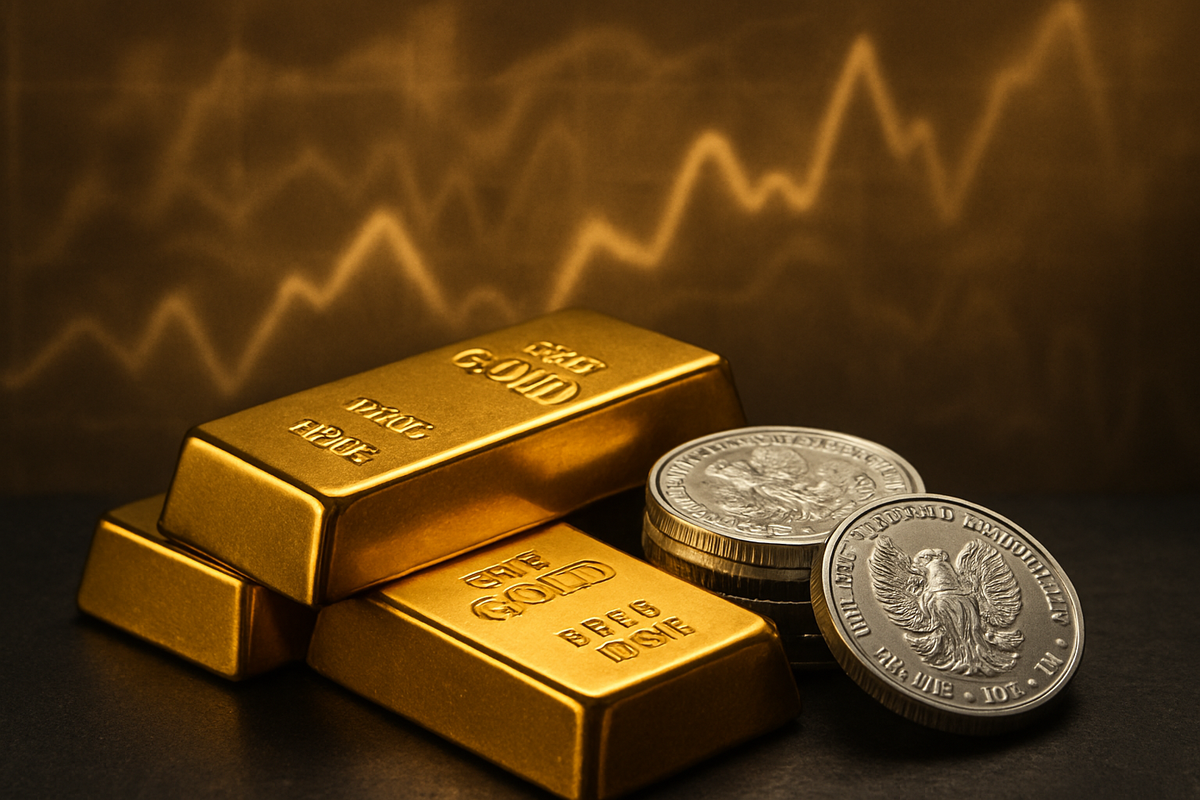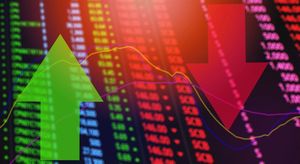
October 17, 2025 - As global inflationary pressures continue their tenacious grip on economies worldwide, precious metals gold and silver are emerging as increasingly attractive havens for investors seeking to safeguard their purchasing power. Despite earlier hopes of a sustained cool-down, inflation has demonstrated its "sticky" nature, with prices for essential goods and services, notably energy and groceries, once again on the rise. This persistent economic backdrop has propelled both gold and silver into unprecedented bullish runs, with prices reaching historic highs and signaling a renewed confidence in their role as tangible assets amidst currency debasement and market uncertainty.
The immediate implications of this inflationary resurgence are clear: investors are flocking to gold and silver as reliable stores of value. Gold, often considered the ultimate safe-haven asset, has seen an extraordinary surge, while silver, benefiting from both its monetary and industrial applications, has experienced an even more dramatic rally. This dual appeal positions these metals not just as a defensive play against economic erosion but also as beneficiaries of the ongoing global push towards green energy and technological advancement, further cementing their critical role in diversified investment portfolios.
Unpacking the Bull Run: A Detailed Look at Gold and Silver's Ascent
The current inflationary environment, while showing some moderation from its July 2022 peak, remains significantly elevated compared to pre-pandemic averages, with certain regions still grappling with acute price increases. This "stickiness" is a complex cocktail brewed from expansive monetary policies, including increased money supply and quantitative easing by central banks, which have devalued currency purchasing power. Compounding this are lingering supply chain disruptions from the COVID-19 pandemic and geopolitical tensions, alongside robust consumer demand fueled by past stimulus, and rising production costs across various sectors. The Russian invasion of Ukraine, for instance, continues to exert upward pressure on energy and food prices, adding to the cost-push inflation.
Against this backdrop, the performance of gold and silver has been nothing short of remarkable. Gold has staged an "extraordinary surge," breaking past the $4,300 per ounce mark and setting an astonishing 40 new all-time highs in 2024. The year 2025 has been particularly stellar for the yellow metal, delivering an impressive 57% gain, with a 47% year-to-date return through September. As of October 17, 2025, gold is poised for its ninth consecutive weekly gain, demonstrating sustained investor confidence. This rally is further underpinned by record institutional inflows into gold ETFs, totaling $17.3 billion in September 2025, coupled with consistent, historically elevated levels of gold accumulation by central banks globally.
Silver's ascent has been equally, if not more, dramatic. The white metal's price surged above $52.50 per ounce in October 2025, reflecting a staggering 76% year-to-date gain and marking its strongest rally since 2011. It even touched a record high of $54.45 per ounce. Starting the year at $28.92 per ounce on January 1, silver climbed to $53.09 by October 16, 2025. This powerful rally is fueled by tight liquidity in the market, soaring lease rates, and a fifth consecutive global supply deficit. Beyond its monetary role, silver's robust industrial consumption, particularly from the rapidly expanding solar photovoltaic sector, acts as a major structural growth engine, ensuring sustained demand irrespective of purely speculative interest. The confluence of these factors paints a clear picture of precious metals as indispensable assets in the current economic climate.
Corporate Fortunes: Winners and Losers in the Precious Metals Boom
The current precious metals boom, driven by persistent inflation and economic uncertainty, creates a distinct landscape of winners and losers among public companies. Gold and silver mining companies, in particular, stand to gain significantly from elevated commodity prices.
Potential Winners:
- Major Gold Miners: Companies like Newmont Corporation (NYSE: NEM) and Barrick Gold Corporation (NYSE: GOLD) are direct beneficiaries. Higher gold prices translate directly into increased revenue and potentially wider profit margins, assuming their operational costs remain stable or are managed effectively. These companies, with their established production capacities and exploration pipelines, can leverage the current price environment to boost earnings and shareholder returns. Their stock prices often track gold prices, albeit with some leverage.
- Major Silver Miners: Similarly, leading silver producers such as Pan American Silver Corp. (NASDAQ: PAAS) and Fresnillo Plc (LSE: FRES) are experiencing a windfall. The dual demand for silver—as a monetary metal and an industrial commodity (especially in solar and electronics)—provides a robust foundation for their profitability. The significant year-to-date gains in silver prices suggest strong financial performance for these companies.
- Precious Metals Streamers and Royalty Companies: Companies like Franco-Nevada Corporation (NYSE: FNV) and Wheaton Precious Metals Corp. (NYSE: WPM) operate on a different model, providing upfront financing to miners in exchange for a percentage of future production or revenue. They benefit immensely from rising commodity prices without bearing the direct operational risks and capital expenditures of mining. Their revenue streams are often tied directly to the spot prices of gold and silver, making them highly leveraged to the current bull market.
- Precious Metals ETFs and Funds: Investment vehicles like the SPDR Gold Shares (NYSE Arca: GLD) and the iShares Silver Trust (NYSE Arca: SLV) are direct ways for investors to gain exposure to gold and silver prices. The record institutional inflows into gold ETFs, as highlighted in the research, indicate strong demand for these products, benefiting the fund managers and increasing their assets under management.
Potential Losers (Indirectly or Relatively):
- Companies with High Input Costs Tied to Inflation: While not directly related to precious metals, companies whose operational costs are heavily impacted by the same inflationary pressures that drive gold and silver prices (e.g., energy, transportation, raw materials) may see their margins squeezed. This could include manufacturers, logistics companies, and some consumer goods producers, whose profitability is eroded by rising input prices, making them relatively less attractive compared to inflation-hedging assets.
- Financial Institutions Dependent on Low-Interest Rates: If central banks are forced to maintain higher interest rates for longer to combat persistent inflation, or if the economic uncertainty leads to a slowdown in lending or investment activities, some financial institutions might face headwinds. However, the research suggests a potential "dovish shift" in central bank policy, which could mitigate this.
- Companies with Significant Debt: In an inflationary environment, if interest rates remain high or increase further, companies with substantial variable-rate debt could face higher financing costs, impacting their profitability and growth prospects.
The overall sentiment favors companies directly involved in the precious metals sector, as their core business is intrinsically linked to the commodities currently serving as critical inflation hedges.
Broader Implications: Navigating a Shifting Economic Paradigm
The sustained rally in gold and silver, fueled by persistent inflation, transcends mere commodity price movements; it signifies a deeper recalibration within the global financial landscape. This event fits squarely into a broader trend of increasing investor skepticism towards traditional fiat currencies and government bonds, especially in an era marked by unprecedented monetary expansion and escalating national debts. The appeal of tangible assets with intrinsic value intensifies when real interest rates (nominal interest rates minus inflation) remain low or negative, making non-yielding assets like precious metals more attractive than cash or low-yielding bonds whose purchasing power is steadily eroding.
The ripple effects of this precious metals surge extend across various sectors. For one, it places additional pressure on central banks globally. While many have aggressively hiked interest rates to tame inflation, the continued strength of gold and silver suggests that these measures have not fully assuaged market concerns about long-term price stability or currency debasement. A potential "dovish shift" in central bank monetary policy, as hinted by market expectations for interest rate cuts, could further accelerate the precious metals rally by reducing the opportunity cost of holding non-yielding assets. This could also signal a recognition by policymakers that the battle against inflation is more protracted and complex than initially anticipated.
Historically, gold and silver have served as reliable barometers of economic stress and hedges against systemic risks. Comparisons can be drawn to periods of high inflation in the 1970s, where gold prices soared, or during the aftermath of the 2008 financial crisis, when quantitative easing led to renewed interest in precious metals. The current environment, however, combines supply-side shocks, demand-pull pressures, and significant geopolitical instability—a potent mix that amplifies the safe-haven appeal of gold. Silver, with its dual role, also benefits from the accelerating green energy transition. Governments and industries worldwide are investing heavily in solar panels, electric vehicles, and advanced electronics, all of which require substantial amounts of silver. This structural demand provides a floor for silver prices, distinguishing its rally from purely speculative bubbles and embedding it firmly within future industrial growth narratives.
Regulatory and policy implications might also emerge. As more capital flows into precious metals, regulators might scrutinize the derivatives markets associated with these commodities to ensure stability and prevent excessive speculation. Furthermore, the sustained strength of gold could influence the reserve asset strategies of central banks, potentially leading to further diversification away from traditional reserve currencies, thereby reinforcing gold's status as a global monetary asset. This broader significance underscores a paradigm shift where tangible, finite assets are regaining prominence as foundational elements of wealth preservation in an increasingly uncertain and inflationary world.
The Road Ahead: What Comes Next for Gold and Silver
The trajectory for gold and silver in the coming months and years appears largely positive, underpinned by a confluence of macroeconomic factors and structural demand shifts. In the short term, the primary drivers will continue to be persistent global inflationary pressures, ongoing geopolitical instability, and the monetary policy decisions of major central banks. Any further indications of "sticky" inflation or unexpected global events are likely to provide immediate upward momentum for both metals. Conversely, any significant and sustained easing of inflation or a decisive hawkish pivot by central banks (though less anticipated now) could introduce periods of consolidation or modest pullbacks. However, such dips are increasingly viewed as strategic buying opportunities within a broader bull market.
Looking further out, the long-term outlook for gold and silver remains robust. Gold's role as the ultimate store of value and a hedge against currency debasement is unlikely to diminish, especially as governments continue to grapple with high debt levels and the potential for future monetary expansion. For silver, its industrial demand, particularly from the burgeoning green energy sector, represents a powerful structural growth driver. The increasing adoption of solar photovoltaic technology, electric vehicles, and 5G infrastructure guarantees a sustained and growing need for silver, creating a continuous supply deficit and exerting upward pressure on prices. This industrial demand acts as a strong fundamental support, insulating silver from purely speculative volatility to some extent.
Potential strategic pivots for investors and institutions will involve a re-evaluation of portfolio allocations. The traditional 60/40 stock-bond portfolio may see adjustments, with a greater emphasis on tangible assets like precious metals to diversify risk and protect against inflation. Market opportunities may emerge in specialized mining companies that are efficiently expanding production or exploring new deposits, as well as in innovative financial products that offer leveraged exposure to precious metals or unique ways to access their value. Challenges could arise from potential regulatory interventions if price volatility becomes extreme, or from unexpected technological advancements that reduce industrial demand for silver (though this seems unlikely in the near future).
Various scenarios could unfold. In a "high inflation, moderate growth" scenario, both gold and silver are likely to thrive. In a "stagflation" scenario (high inflation, low growth), their safe-haven appeal would be even stronger. Even in a "disinflationary but uncertain" environment, geopolitical risks and currency concerns could still support demand. The most bearish scenario would involve a rapid and sustained return to low inflation and high real interest rates, which appears less probable given current global economic dynamics. Overall, the stage is set for gold and silver to remain central to investment strategies focused on wealth preservation and growth in the face of ongoing economic transformation.
Wrap-Up: A Resilient Future for Precious Metals
The ongoing saga of global inflationary pressures has unequivocally cemented gold and silver's status as indispensable assets in the modern financial landscape. The key takeaway is clear: in an era characterized by persistent price increases, geopolitical instability, and the specter of currency debasement, these precious metals offer a time-tested and increasingly relevant hedge against the erosion of purchasing power. Gold's extraordinary surge past $4,300 per ounce and silver's remarkable climb above $52.50 per ounce in October 2025 are not mere speculative bubbles but rather a powerful market signal reflecting fundamental shifts in investor confidence and economic realities.
Moving forward, the market will likely continue to assess the interplay between central bank policies, the stubbornness of inflation, and global geopolitical developments. The expectation of potential dovish shifts in monetary policy, coupled with strong institutional and central bank buying, provides a robust foundation for continued strength in gold. Silver, with its unique dual role as both a monetary metal and a critical industrial commodity—especially vital for the burgeoning green energy sector—enjoys an additional layer of demand support that promises sustained growth. Its ongoing supply deficits further underscore its strong market position.
The lasting impact of this period will likely be a permanent re-evaluation of portfolio diversification strategies, with a greater emphasis on tangible assets. Investors should closely watch for key economic indicators, particularly inflation data and real interest rates, as well as any communications from central banks regarding their future policy trajectories. Geopolitical headlines will also remain crucial, as any escalation of tensions will invariably boost safe-haven demand. In essence, gold and silver are not just reacting to current events; they are actively shaping the narrative of wealth preservation and investment strategy in a world grappling with profound economic uncertainty. Their resilience and continued ascent underscore their enduring significance as pillars of financial stability.
This content is intended for informational purposes only and is not financial advice






